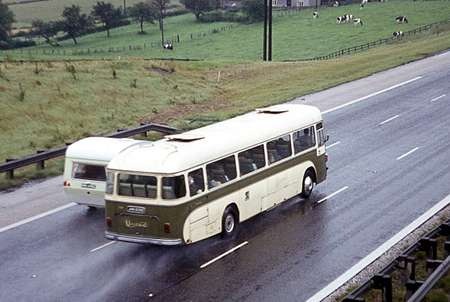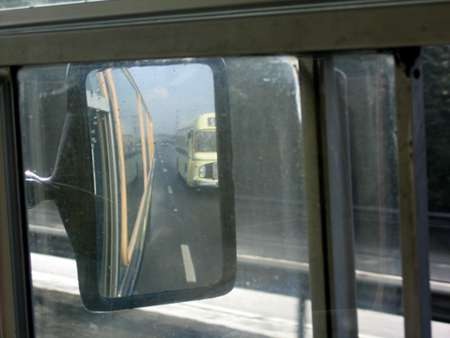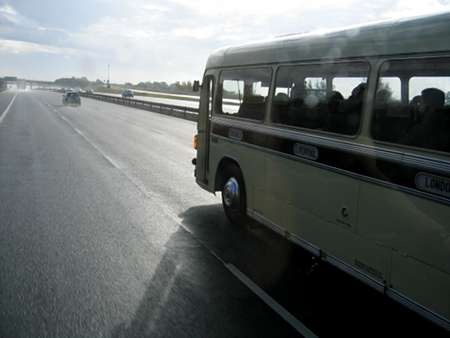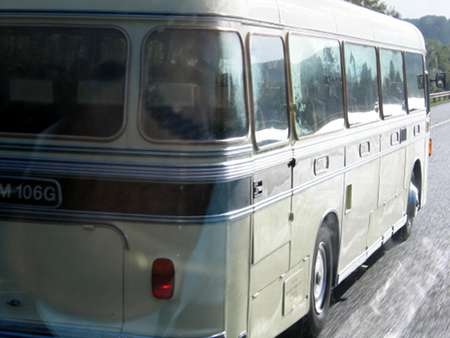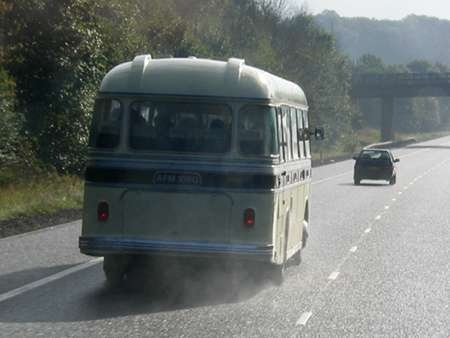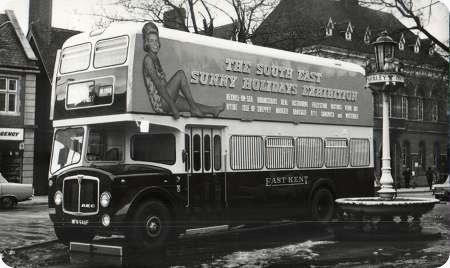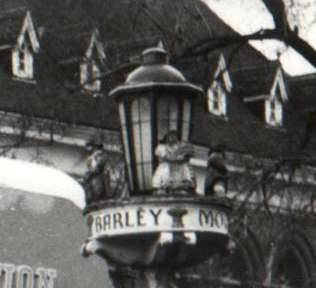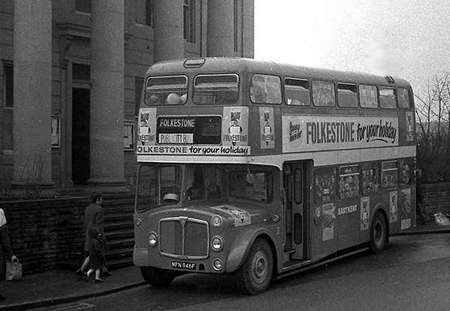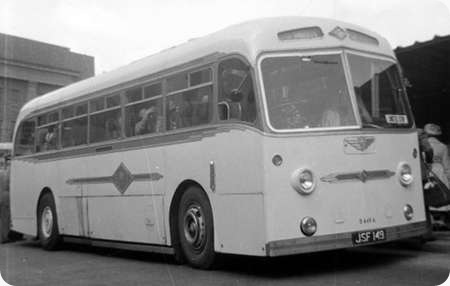United Automobile – Bristol RE – 104 VHN – RE4
United Automobile Services
1964
Bristol RELH6G
ECW C43F
104 VHN, was new in January 1964, with the fleet number BRC4; I am not sure when the last of the type were delivered, but the ECW bodied RELH6G’s were among the last United vehicles to carry this understated and distinctive livery. Some of the early Plaxton bodied Bristol’s did, but most had the ghastly, or should that be ghostly, all white, one size fits all NBC livery. United coaches had a well-deserved reputation for passenger comfort, obviously they were used on other duties but the primarily role for many of these was the long haul to London, and so United specified the more spacious 43 seat variants, whereas most of the Tilling group had the 47-seat version. Arguably, other vehicles of the era may have been better looking, but as far as build quality and reliability is concerned, these were as good as it gets. The level of comfort they offered, coupled with their exceptional ride quality and the ultra reliability of the Gardner H6LXB engine made them an act that was extremely hard to follow, and many would say has never been surpassed. Once in London, the crews stayed until the next day before returning, but the vehicles had a turnaround of about three hours, during which they were cleaned out and refuelled at Samuelsons. In a 24 hour period, they would do a full round trip of over 600 miles, and it was nothing unusual for them to clock up over 4,000 miles a week, most of them accumulated phenomenal mileages during their lives. I know that several from other companies have survived, but I’m not aware that any of United’s have.
Photograph and Copy contributed by Ronnie Hoye
27/03/14 – 06:58
I’ve said it before. RELH/ECW – possibly the ultimate class act.
David Oldfield
27/03/14 – 06:59
I happened on this web-site by accident searching for any books on "United" I started with the Company at the Scarborough depot in 1955 and this was intended just for the season, and I was employed as a Conductor, after two seasons being laid off in September known as Surplus to requirements I was finally given a full time job in 1957 and after a variation of jobs finally retired in 1990 having been transferred to E Y M S because of deregulation.
I have one Bus photograph of fleet no B G L 59 and it was taken when I was in the Driving school, I think it was a 5 Cylinder Gardner, I have other Memorabilia such as long service awards, safe driving awards and I still have my P S V badge BB 40875, and also lots of memories of ex staff.
Gordon England
28/03/14 – 07:11
Couldn’t agree more David, and thanks for posting Ronnie. The coach looks simply glorious.
Brendan Smith
28/03/14 – 07:11
On paper, a livery of olive green and cream sounds rather less than prepossessing, but, in practice, the United coach livery was a peerless example of dignified restraint that exuded quality. How one yearns for the return of such schemes in place of the present day ostentatious eyesores from the likes of Best Impressions. The Bristol RELH was a classic coach, and I firmly believe that, updated to meet modern requirements, it could still present a serious challenge in the present day market place.
Roger Cox
28/03/14 – 07:12
Here’s one of the fine machines I captured in 1970, doing its ‘job’ on the M1 south on a wet Sunday afternoon in Derbyshire.
Berisford Jones
28/03/14 – 17:51
Couldn’t agree more on every count Roger.
David Oldfield
28/03/14 – 17:52
The ultimate quality coach; I don’t think any other coach was better looking – except perhaps similar vehicles in Royal Blue livery. These coaches were a joy to drive – some drivers complained about the manual gearbox version, but I had no trouble with them. No other type of coach had such a relaxing, subdued sound, even when travelling at high speed.
Don McKeown
28/03/14 – 17:53
Nice action photo, Berisford. Amazing to think that, on Ronnie’s calculations, this vehicle would have clocked up some 1,248,000 miles by 1970!
Chris Hebbron
29/03/14 – 07:45
Don, that relaxing subdued sound was the superbly engineered Gardner engine. Even when flat out they were revving at less that 2.000 RPM, which is only about twice what a modern car will tickover at, so a run on the motorway was just a leisurely stroll to them.
Chris, as I said, they had other duties, but 600 plus miles a day was the norm on the London run. Not every depot that had them operated that service, so in all probability they would have been periodically swapped around in an effort to even out the mileage. Nevertheless, in those days odometers returned to zero at 100,000 miles. and I know for a fact that by the time some of the first intake at Jesmond depot were a year old, most of them were nearing the end, and some had passed their second time round the clock.
Ronnie Hoye
29/03/14 – 07:47
It’s absolutely incredible to think that this superb coach was new fifty years ago! I had the pleasure of riding on a Midland General example a few times, manual gearbox, a turn of speed which was breathtaking and a ride which was almost silent. Today’s National Express offerings don’t even come close!
Chris Barker
29/03/14 – 08:19
A front view of sister United Autos Bristol RE 105 VHN. Seen here in Doncaster on a Service 203 to Newcastle.
Stephen Howarth
29/03/14 – 09:06
Sorry to show my ignorance but bearing in mind the plaudits given for the quiet and smooth ride of the RELH, can somebody please bring me up to speed with the engine configuration and drive train on these classic vehicles.
John Darwent
29/03/14 – 12:01
Series 1 sanctioned for the nationalised Tilling/Transport Holding Company set up. Rear engined – most Gardner 6LXB, some Leyland O.600 or O.680. Bristol 5 speed synchromesh manual gearbox. [Air suspension standard fitment.]
Series 2 on open market. Similar drive train/power source as Series 1. Gardner 6LXB/Leyland 0.680 in roughly 2:1 proportion. Menu of fittings and options for open market which also meant that the air suspension became an option rather than standard. 5 speed epicyclic (semi-automatic) gearbox became standard on Series 2.
Series 3 never saw the light of day. Further improvements were at the planning stage when BLMC pulled the plug on the RE in favour of the Leyland National but also axed the RELH in favour of an improved Leyland Leopard. A spring parking brake got as far as at least one West Yorkshire RE.
David Oldfield
29/03/14 – 18:47
Just to add a little to David’s comprehensive note, the engine in the RE was horizontally mounted, unlike the current crop of ‘modern’ rear engined single decks. The gearbox was mounted forward of the rear axle and the drive from the engine went over the axle to the gearbox and then back again to the differential. This configuration allowed the fitment of a propshaft of adequate length to allow for suspension travel in the drive train. Some other designs, notably the Seddon RU, fell lamentably short on this design requirement.
Roger Cox
29/03/14 – 18:48
Thank you for that info David. I seem to recall that RE’s had longitudinally mounted engines rather than transversely as became the fashion in service buses. Noting from a previous post that you have had the pleasure in later life of driving RE’s, you may be able to comment on the gear change of the manual models bearing in mind the lengthy linkage presumably involved. How come an academically minded O.E. as yourself came to be at the wheel of such revered vehicles? Fat Nat would spin in his grave!
John Darwent
30/03/14 – 07:45
The manual gearbox was something a driver needed to make an effort to master but once mastered it was easy and light to use although there seemed to be too big a gap between 2nd and 3rd gears which could be a problem on rising gradients. The most difficult thing to master when timing the gear changes was hearing the engine revs due to the overall quietness of the body and engine especially with a good load on. One thing to beware of was selecting reverse with the heater control in the midway position on the ECW bodies as it was easy to get a finger trapped between gearstick and the control.
Diesel Dave
30/03/14 – 07:45
John. Nat retired after my first year and Flink was acting Head until the Sharrock era. Strangely enough my (fully MOT approved) driving instructor was a master at KES. He also got me through the Advanced test (IAM) whilst I was at music college. I had been interested in buses from a babe in arms but it was my oldest friend from KES who twisted my arm to get my PSV. [He is about to retire as a Managing Director of Stagecoach Bus.] I only ever rode on Series 1s and only drove Series 2s in preservation. I write after playing for a concert in Kingston last night and about to play a morning service prior to driving RML2440 this afternoon on the new Watford running day. [So no rest for the wicked.] Roger’s addendum is, of course, correct.
David Oldfield
30/03/14 – 09:44
Thank you Diesel Dave for the interesting comments and scenario.
David O, what an amazing tale. I was a few years earlier than your goodself at KES and there was little interest in transport matters at the time. Having said that, if we go earlier still there was Terry Ellin, later to find fame with his restoration of Leyland Comet coach MHY 765. Hope you have a great day with RML 2440.
John Darwent
31/03/14 – 07:19
The layout of the Bristol RE was an absolute masterpiece in chassis design, offering a low step height and comfortable ride for passengers, yet keeping the engineering staff happy by offering easy access to all the major mechanical components. From a driver’s viewpoint the RE did not seem to show any of the tail-heavy characteristics of other rear-engined single-deckers, due to the better weight distribution of its major components, and from the traffic department perspective the RE would be suitable for PAYE operation. As David O. comments, the Series I chassis for the THC ‘Tilling’ fleets used Gardner’s 6HLX engines in the main, although a few operators did specify the smaller 6HLW. When Leyland took a 25% stake in Bristol (and ECW) in the mid-sixties this allowed the company access to the open market, and the Leyland 0.600 engine option became available, with the 0.680 following a little later. Interestingly the RE Series II was offered with AEC AH505 and AH691 engine options, but sadly none were ordered. (Bet you’d liked to have heard one of those David. The 691 would have sounded gorgeous coupled to the RE exhaust). Ulsterbus specified Gardner’s more powerful 6HLXB (Up to 180bhp available at 1850rpm compared to the HLXs 150bhp at 1700 rpm) in some of its later RELL6Gs. They must have sounded grand as well.
Brendan Smith
31/03/14 – 12:44
John. Had a very good day with RML2440, thanks. Didn’t know where I was going (but didn’t get lost) and discovered new bits of Metropolitan Hertfordshire. Didn’t realise Terry was an OE. In my time we had a informal "Bus Club" of 6th formers and met under the balcony in the hall. Two of us became musicians/music teachers, one the Stagecoach director, one an English teacher (and subsequently an operator), one a civil servant and one a research scientist – and all, as you say, academically minded graduates.
Brendan. It would take a lot to beat a ZF Reliance but I did know about the AEC option for REs. Now that would have been spectacular. [Reading documents referring to LT and the Merlin one gets the impression that, apart from the "breaking back" syndrome found in other rear engined vehicles, the other problem was cooling. Much of this centred round failing convoluted piping caused in part by the lay out in the engine compartment. Presumably, this would not be a problem the an AEC/RE either?]
David Oldfield
02/04/14 – 08:23
Berisford’s action shot of one of United’s fine RELH6Gs on the motorway reminded me of a ‘minor difficulty’ that beset West Yorkshire when it took delivery of a batch of six RELH/ECW coaches in 1970. These fine machines were to have been delivered with Gardner 6HLX engines, but due to demand for such outstripping supply at the time, Leyland 0.680 engines were substituted. (The coaches were delivered as CRG17-22, but renumbered CRL1-6: CWY498-503H). Upon entering service, it soon became apparent that an unforseen problem was causing the company some embarrassment. The Gardner engines were to have been rated at the usual 150bhp at 1700rpm, but the substituted Leyland units developed 150bhp at 2200rpm. However, as the rear axle ratios were geared for the lower engine speeds of the Gardners, the higher rpm of the Leyland engines gave the CRLs an impressive (and illegal) top speed on the motorway. After several cautions from the boys in blue regarding 85 mph West Yorkshire coaches, the fuel injection pumps were removed and recalibrated to give 150bhp at 1800 rpm. This was a much quicker, cheaper and more practical solution to the problem, rather than replacing the rear axle innards. After this modification, things settled down to a gentler pace. Drivers did report though that the Leylands were still a little faster on the flat, but that the Gardners would still pass them on the hlls.
Brendan Smith
07/04/14 – 16:06
I noticed one of the recent articles on the RE mentions action shot on the motorway well here are some more. The cab shot is a Royal Blue Bristol RE Manual gearbox being overtaken by a Crosville Semi-Automatic Bristol RE on our way to the Duxford bus ralley in 2006. Both vehicles are in preservation.
Michael Crofts
08/04/14 – 07:53
Good action shots, Michael.
I see 90mph on the speedo of the first shot, so that overtaking RE must’ve really been motoring!!!
Chris Hebbron
08/04/14 – 07:54
Brendan, it was much the same story with the NGT Group Fanfare’s. The Wakefields AEC Reliance versions were a fraction faster on the flat, but the NGT Gardner engined GUY Arabs would leave them for dead uphill.
Ronnie Hoye
08/04/14 – 11:04
Sorry to shatter the illusion Chris, but the vehicle is fitted with a tachograph, so the speed is recorded in KPH not MPH. 100 KPH is 62.5 MPH.
Ronnie Hoye
08/04/14 – 16:58
You’re right, Ronnie, I’m really shattered!
Chris Hebbron
08/04/14 – 16:58
Not that something approaching that wouldn’t have been possible when new. Did over the ton in a ZF Reliance (I wasn’t driving) on the A1M before Tachos and 70mph limits.
David Oldfield
09/04/14 – 08:18
I seem to recall that our motorways, initially, had no speed limits on them. However,coaches, in particular, were reaching speeds of 90mph (in the very late ’50’s and early ’60’s) and there were a few accidents, mainly due to tyre technology being up to the new challenges, hence the introduction of the 70mph speed limit. I can recall doing 75mph in my car on the M4 and being well-overtaken by coaches!
Chris Hebbron
09/04/14 – 13:11
Doesn’t Chris mean ‘tyre technology "NOT" being up to new challenges’?
Stephen Howarth
09/04/14 – 18:00
Yes, I did!
Chris Hebbron
12/04/14 – 08:06
Both coaches were cape able of exceeding 70 mph.
Michael Crofts
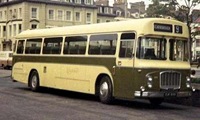 Vehicle reminder shot for this posting
Vehicle reminder shot for this posting
24/04/14 – 08:12
How well I remember these lovely coaches which finally saw the ECW bodied models delivered in 1970. In my younger days I often travelled to London on the dsytime service returning some days later on the overnight 206 to Middlesbrough and without doubt the real highlight of my holiday was the journey to and from London on board one of these coaches. It was sad to see them demoted in later life with headrests cut down and I seem to remember even the roof lights bolted down. Sadly none ever survived long enough of the 95 delivered to see preservation.
Here is an early view of two of the examples taken at Hawes in North Yorkshire in October 1972. Fleet number 1253 was based at Redcar who in United days used to operate excursions and this outing was one of the popular six lakes ones. They also ran another E registered example. It’s one of my early views so sorry about the quality.
Ken Hoggett
27/05/14 – 15:23
Ken’s comment about their latter days is spot on. I encountered them when they were running longer stage routes such as Scarborough-Helmsley and Berwick-Seahouses in their last years. They still rode well and sounded good but they looked terribly down-at-heel internally. Some (cf the EFE model) ended up in NBC red- enough said.
Phil Drake
Quick links to the - Comments Page - Contact Page - Home Page

